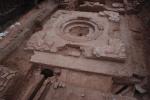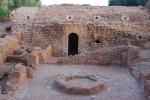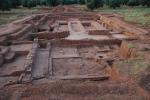Summary (English)
From june 2005 an international scientific program has concentrated around the medieval capital of Morocco, Aghmat – archaeological exploration, conservation and preservation of the monuments revealed by the excavation, and a concentrated program to raise awareness of the site with the local public and with tourists. Under the scientific responsibility of Abdallah Fili (University of El Jadida) and Ronal Messier (MTSU) the objective is to study, protect, transmit and publicize this important Moroccan heritage site, whose historic value is incalculable.
The position of the town
The medieval site of Aghmat is found near the modern village of Ghmat, 30 km to the southeast of Marrakech. The site lies on the southern edge of the plain of Haouz in contact with the northern foothills of the High Atlas. It occupies a place of choice in the middle of the rich valley of the Oued Ourika which constitutes one of the principle passes through the Atlas.Medieval Aghmat
Known from sources to have pre-existed the arrival of Islam in Moroco inn the seventh century, it flourished under the Idrissid dynasty in the eighth and ninth centuries and was raised to the rank of capital at the end of the tenth century and then under the Almoravids, in the eleventh and twelfth centurys. From Aghmat, this dynasty founded Marrakech in 1070. From then on, the competition between the two cities ended with the victory of the latter, and the end of the prosperity of the former. The site was abandoned towards the end of the fourteenth century.
As a major circulation point for Transaharan commerce, Aghmat drew merchants and scholars from Ifriqiya (Tunisia) and al-Andalus (Spain). Still today, the cemeteries of the town hold the tombs of kings and poets from Andalucia – the poet al-Mu’tamid ibn Abbâd of Seville and Abdallah Ibn Bûlûkhin of Grenada – and of Sufis from all parts of the Muslim world to find science, faith and pease. The famous Zaynab Nafzawiyya, daughter of a great merchant of Ifriquiya, found refuge there with her family. She subsequently married four of the emirs of the town, first under the Maghrawa and then under the Almoravids. There is a tradition that she was the person who chose the site for the foundation of the town of Marrakech.Archaeological discoveries
The various archaeological campaigns have revealed the center of the town and its public monuments. It is composed of a hammam of the tenth-fourteenth centuries, a palace (eleventh-fourteenth centuries) and a great mosque (ninth-fourteenth centuries). This unique ensemble demonstrates the importance of the city and its organization, so far unknown except for the descriptions of the great geographers and Arab historians of the Maghreb.Conservation
If excavation is primary, consolidation and preservation is of equal importance, in order to be able to transmit to future generations this exceptional heritage. The monuments are sometimes extremely well-preserved: this is the case with the hammam, which still has its vaults.
Excavation puts these sites at risk, and exposes them to weather and human vandalism. Thus conservation was begun almost as soon as excavation, respecting the matrials and techniques of the original construction: the aim is thus to consolidate and protect the ruins and to render the site accessible to the public.Finds
A large number of finds was revealed by the excavation: pottery, jewelry, coins, sculpture, carved plasterwork and painted plaster. This collection remains to be studied, and needs to be displayed in a museum on the site.
- Abdallah Fili
Director
- Abdallah Fili
- Ronald Messier
Team
- Ahmed Ettahiri
- Chloé Capel
- Claire Déléry
- Hassan Limane
- Violaine Héritier-Salama
- Sandrine Zanata
Research Body
- Direction du patrimoine culturel (Maroc)
- MTSU
Funding Body
- AIMS
- Barakat Trust
- Commission maroco-américaine
- Fondation Aghmat
- Fondation Majorelle
- MTSU Foundation






![Download [PDF]](/excavation/skins/fasti/images/results/download_sml.png)


